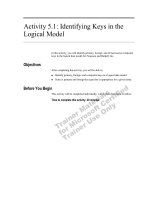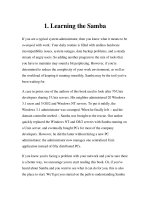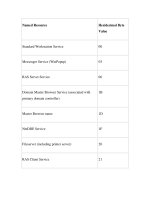5 1 learning about the first americans
Bạn đang xem bản rút gọn của tài liệu. Xem và tải ngay bản đầy đủ của tài liệu tại đây (2.81 MB, 10 trang )
LEARNING ABOUT
THE
Fascinating Facts
FIRST AMERICANS
• California has the highest present-day American
Indian population of any of the fifty states.
• Some American Indian mothers carried infants in
a cradleboard, a lace-up bag made of animal skin
on a wooden frame.
• Corn, beans, and squash were important foods to
the American Indians. The Iroquois called them the
“three sisters.”
Genre
Nonfiction
Comprehension Skill
Summarize
Text Features
• Sidebar
• Captions
• Glossary
Scott Foresman Social Studies
ISBN 0-328-14885-7
ì<(sk$m)=bei fb< +^-Ä-U-Ä-U
by Stephanie Sigue
Write to It!
In different areas of the United States, archaeologists dig
for clues about the past lives of American Indians. In this
book you will read about how archaeologists search for
information that will add to our understanding of the way
these people lived long ago.
Write a paragraph comparing either the tepee
used by American Indian groups of the Great
Plains or the cliff dwellings of American Indians of
the Desert Southwest to one of the dwellings built
by American Indians of another region.
LEARNING ABOUT
THE FIRST AMERICANS
Write your paragraph on a separate sheet
of paper.
Vocabulary
archaeologist
artifact
longhouse
lodge
tepee
pueblo
mesa
Photographs
by Stephanie Sigue
Every effort has been made to secure permission and provide appropriate credit for photographic material. The publisher deeply
regrets any omission and pledges to correct errors called to its attention in subsequent editions.
Unless otherwise acknowledged, all photographs are the property of Scott Foresman, a division of Pearson Education.
Photo locators denoted as follows: Top (T), Center (C), Bottom (B), Left (L), Right (R) Background (Bkgd)
ISBN: 0-328-14885-7
Copyright © Pearson Education, Inc.
All Rights Reserved. Printed in the United States of America. This publication is protected
by Copyright, and permission should be obtained from the publisher prior to any prohibited
reproduction, storage in a retrieval system, or transmission in any form by any means,
electronic, mechanical, photocopying, recording, or likewise. For information regarding
permission(s), write to: Permissions Department, Scott Foresman, 1900 East Lake Avenue,
Glenview, Illinois 60025.
1 2 3 4 5 6 7 8 9 10 V0G1 14 13 12 11 10 09 08 07 06 05
Opener: ©Bettmann/Corbis
2 ©Warren Morgan/Corbis
3 ©Stock Montage Inc.
4 ©The Image Works, Inc.
5 ©Marilyn “Angel” Wynn/Nativestock
6 ©North Wind Picture Archives
8 ©Bettmann/Corbis
9 ©Nancy Carter/North Wind
PictureOffices:
Archives Glenview, Illinois • Parsippany, New Jersey • New York, New York
Editorial
10 ©Joseph Sohm; ChromoSohm Inc./Corbis
12 ©Hemera Technologies/Alamy
Sales Offices: Needham, Massachusetts • Duluth, Georgia • Glenview, Illinois
13 ©Ernest Manewal/SuperStock
Coppell, Texas • Sacramento, California • Mesa, Arizona
14 ©Tom McHugh/Photo Researchers, Inc.
15 ©George H. H. Huey/Corbis
American Indians of the
Eastern Woodlands
Archaeologists work at a dig in Wenatchee, Washington.
When an archaeologist begins to study a group
of people, he or she hopes to answer some questions.
When and where did these people live? What can we
learn about how they lived? What kinds of artifacts, or
things people made in the past, have they left behind?
For many centuries different groups of American
Indians, or Native Americans, lived in what is now the
United States. Nature always played an important part
in their lives. We can learn how American Indians lived
long ago from the knowledge that has been passed to
American Indians today. More can be learned from the
work of archaeologists.
2
One of the major groups of the Eastern Woodlands
were the Iroquois. The name Iroquois refers to the
members of several American Indian groups. These
groups included the Mohawk, the Seneca, the
Onondaga, and the Oneida.
The Iroquois were farmers who lived in the forests of
the Eastern Woodlands. They used trees to build their
villages, homes, and some of their tools.
Iroquois villages were built on hills so that the
villagers could see the enemy in case of an attack. Some
villages were large and had a population of one
thousand people. A fence made of logs protected each
village.
The Iroquois lived in longhouses. A longhouse was
about 20 feet wide and between 75 feet and 120 feet
long. It was made of wooden poles covered with bark.
Inside a longhouse were places to store things and
places for families to live.
This model shows an Iroquois longhouse.
In what is the present-day Southeastern United States,
American Indians lived in towns. Each town had three
common features. A circular meetinghouse was where
town leaders met. There was a town square where
religious events took place, and there was a large court
where games were played.
This picture shows a Creek log house.
A Seminole chickee has open sides.
The Creek, the Choctaw, and the Cherokee all lived in
what is the present-day Southeastern United States. They
lived in plain rectangular houses. Houses were made
from wood, and each had a roof made from straw or
tall plants.
The Seminole, originally part of the Creek, lived in
Florida, where it was hot, humid, and swampy. They
built small houses with open sides called chickees. The
houses were built on platforms so they did not flood
during the rainy season.
4
5
This is an example of a Mandan village in the 1800s.
American Indians of the
Great Plains
The Great Plains were home to many different groups
of American Indians. Some Plains Indians stayed in one
place. These groups, which included the Pawnee, the
Omaha, and the Osage, lived in earth lodges.
Their lodges were square with a floor that was below
ground level. Large wooden posts made the corners.
Thin poles were used for walls and long poles formed
the roof. Mats of woven grass covered the poles. An
opening, or smoke hole, was left in the roof’s center.
Starting at the base, the builders applied a coat of mud
to the walls. The mud kept the house warm during the
winters and cool during the summers.
6
The Mandan and the Hidatsa lived in villages along
the upper Missouri River in North Dakota. They built
lodges made from earth and winter lodges near a large
wood supply. The Mandan and the Hidatsa needed
wood to make fires.
Each earth lodge was very large. A lodge had a
dome shape and could be forty to sixty feet wide and
fifteen feet high. The roof was made of wooden beams
and was covered with willows, grass, and sod.
A family’s belongings, including dogs and horses,
were all kept inside the lodge. Horses were kept inside
so they would not be stolen.
Changing Ways of Life
In the 1500s Spanish explorers brought
horses with them to North America. This
changed the ways of life of American Indians
of the Great Plains. Horses made hunting easier
and allowed American Indian groups to travel
farther and faster. Over time, many of these
groups became nomads who moved from place
to place.
7
Many American Indian groups of the Great Plains
did not stay in one place. They were nomads who
moved from place to place. The Sioux, the Cheyenne,
the Comanche, the Blackfoot, and the Crow were all
nomads. They hunted buffalo and followed the buffalo
herds.
Because groups of the Great Plains were always on
the move, they needed dwellings that were easy to
carry, so they designed the tepee. A tepee could be
packed up and carried away easily. It had a coneshaped frame made from long, tall poles that were tied
together at the top.
Tepees were covered with buffalo hides. Once a year, each
tepee was covered with a new, fresh hide.
The remains of this pit house include a fire pit and a
storage room.
American Indians of the
Desert Southwest
American Indians of the Desert Southwest lived in a
variety of dwellings. The early Mogollon (moh-GOHyohn) and the Hohokam (huh-HO-kum) people built pit
houses. These houses were partly underground.
Each pit house was a rectangle with wooden poles
that leaned in to support the roof. This created side walls
that sloped. The roof and walls were covered with
branches, grass, and a thick layer of adobe, or mud.
8
9
American Indian cliff dwellings and pueblos are two
finds made by archaeologists in the Desert Southwest.
Cliff dwellings were found in an area called Mesa Verde
(MAY-seh VEHR-dee). A mesa is a hill with a flat top
and steep sides. Mesa Verde is in an area called the
“Four Corners.” This is where the present-day borders of
Utah, Colorado, New Mexico, and Arizona meet. Here
the ancient Anasazi people built their homes in the steep
sides of the mesa. Archaeologists call the people who
lived in these places cliff dwellers.
Some American Indian pueblos were like large
apartment buildings. These “great houses” contain
hundreds of rooms and underground chambers. Some of
the largest and most famous great houses are in Chaco
Canyon, New Mexico. One called Pueblo Bonito has
about eight hundred rooms. Archaeologists believe there
was room for as many as three thousand people in this
great house.
The largest cliff dwelling in Mesa Verde is called the Cliff
Palace. It had 217 rooms and 23 kivas. A kiva is an
underground room that was used for special ceremonies.
10
11
People have found American Indian arrowheads all over
the United States.
Art and Other Objects
Archaeologists also look for tools, weapons, clothing,
pottery, and baskets. All of these things can help them
learn more about ancient people.
Tools and weapons can tell scientists how people
hunted for food. From the size and weight of a weapon,
scientists can tell how hunters used it.
Before the Europeans arrived in North America,
American Indian women made clothing from
animal skins. They also decorated clothing
with porcupine quills. Some dyed the quills
before sewing them onto clothes.
This beadwork showing an eagle
appears on a Tlingit (TLING-git)
ceremonial robe.
12
The Europeans brought new materials with them,
including glass beads. American Indian women began
to use fancy beadwork to decorate clothing. Often they
created pictures of animals, such as thunderbirds.
The National Museum of the American Indian
in Washington, D.C., contains more than 800,000
objects. The objects are from North and South America
and span ten thousand years of American Indian history.
There is still much to learn about how American
Indians lived long ago, and archaeologists continue
to dig for answers. What archaeologists learn from
artifacts and the histories passed on to American Indians
today help us understand how American Indians lived
long ago.
This painted Sioux flat
pouch was made of
buffalo rawhide.
This Anasazi bowl was
made in the 1300s.
The buffalo was an important animal to American
Indians of the Great Plains. It was a major source
of food. Its skin was used to make both clothing and
homes.
Many American Indians were—and are—expert
potters, basket makers, and weavers. Today their objects
are prized possessions of individuals and museums
around the world.
14
15
Write to It!
Glossary
archaeologist a scientist who studies the
In different
areas
the United
States,
dig
artifacts
ofofpeople
who lived
longarchaeologists
ago and
for cluesdraws
aboutconclusions
the past lives
ofthem
American Indians. In this
from
book you will read about how archaeologists search for
artifact an object made by people in the past
information that will add to our understanding of the way
large,
round
these lodge
people a
lived
long
ago.hut built by American Indian
groups of the Great Plains
Write a paragraph comparing either the tepee
used by American Indian groups of the Great
Plains or the cliff dwellings of American Indians of
the Desert Southwest to one of the dwellings built
by American Indians of another region.
Write your paragraph on a separate sheet
of paper.
longhouse a building used for shelter by
Vocabulary
the Iroquois
archaeologist
mesa a high, flat landform that rises steeply from
the land around it artifact
longhouse
pueblo an American Indian village of the Desert
Southwest region oflodge
the United States, typically
made up of stone ortepee
adobe dwellings
tepee a dwelling built
by American Indians of the
pueblo
Great Plains
mesa
Photographs
Every effort has been made to secure permission and provide appropriate credit for photographic material. The publisher deeply
regrets any omission and pledges to correct errors called to its attention in subsequent editions.
Unless otherwise acknowledged, all photographs are the property of Scott Foresman, a division of Pearson Education.
Photo locators denoted as follows: Top (T), Center (C), Bottom (B), Left (L), Right (R) Background (Bkgd)
ISBN: 0-328-14885-7
Copyright © Pearson Education, Inc.
All Rights Reserved. Printed in the United States of America. This publication is protected
by Copyright, and permission should be obtained from the publisher prior to any prohibited
reproduction, storage in a retrieval system, or transmission in any form by any means,
electronic, mechanical, photocopying, recording, or likewise. For information regarding
permission(s), write to: Permissions Department, Scott Foresman, 1900 East Lake Avenue,
Glenview, Illinois 60025.
1 2 3 4 5 6 7 8 9 10 V0G1 14 13 12 11 10 09 08 07 06 05
16
Opener: ©Bettmann/Corbis
2 ©Warren Morgan/Corbis
3 ©Stock Montage Inc.
4 ©The Image Works, Inc.
5 ©Marilyn “Angel” Wynn/Nativestock
6 ©North Wind Picture Archives
8 ©Bettmann/Corbis
9 ©Nancy Carter/North Wind Picture Archives
10 ©Joseph Sohm; ChromoSohm Inc./Corbis
12 ©Hemera Technologies/Alamy
13 ©Ernest Manewal/SuperStock
14 ©Tom McHugh/Photo Researchers, Inc.
15 ©George H. H. Huey/Corbis









